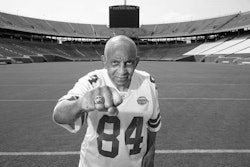The annual academic status report for bowl-bound college football teams was released nationally Monday morning. With that, two main observations came to mind for attorney Len Elmore, a noted educational advocate for a better balance between academic awareness and campus sports pursuits in the lives of major college athletes.
“The report is both revealing and frightening,” Elmore, a college basketball television analyst and former member of the Knight Commission on Intercollegiate Athletics, told Diverse. “That the College Football Playoff participants still have a long way to go in bringing parity to the (graduation rates) between Black and White athletes.” 
He continued: “Michigan State graduates 100 percent of its White football players compared to 72 percent of all football players and 87 percent of all student-athletes. Yet, a mere 57 percent of Black football players graduate in East Lansing.”
Michigan State is headed to the Holiday Bowl.
The racial disparity in graduation rates for Black and White football players is featured prominently in the report despite a bit of good news in comparison to last year’s results.
The good news: Overall academic progress for college football players continues on an upward trend.
Dr. Richard Lapchick, the primary author of the report, said, “The academic success of FBS football student-athletes continued to grow this year. The overall football student-athlete Graduation Success Rate (GSR) for bowl-bound teams is 77 percent, up from 75 percent in 2016.”
Lapchick’s annual report, which is conducted by The Institute for Diversity and Ethics in Sport (or TIDES) at the University of Central Florida in Orlando, serves as a measuring stick for the sometimes tenuous relationship between academics and athletics, as major college players prepare to participate in the 39 bowl games.
The report, which uses statistics from the NCAA, is called “Keeping Score When It Counts: Assessing the Academic Records of the 2017-2018 Bowl-bound College Football Teams.” It includes GSR, a measurement that shows the proportion of football players on a team who earn college degrees, and APR or Academic Progress Rate, which measures a football player’s chances for graduation.
Of the four College Football Playoff teams, these metrics bear noting:
Clemson, Alabama, Oklahoma, and Georgia all had reasonable academic standing, though Georgia lagged a bit in some categories. The APRs for Clemson and Alabama led the foursome with a 980 score, which ranks them among the top 20 out of the 78 bowl-bound teams.
Oklahoma followed with a 965 and Georgia was last at 961. Their overall graduation rates, respectively, were 85 percent, 84 percent, 72 percent, and 53 percent.
As for their Black players, those schools graduated, respectively, 81 percent, 79 percent, 65 percent and 44 percent of them. Their White football players graduated at rates of 100 percent, 95 percent, 89 percent, and 73 percent. And for the overall student-athletes at the schools, the graduation rates, respectively, were 91 percent, 90 percent, 83 percent and 83 percent.
“Certainly, there are skeptics among us who openly wonder what kind of courses are the athletes taking,” surmised Elmore, a former All-America college basketball player at Maryland before entering the NBA. “Are they tracked into easy and even remedial courses of study simply to remain eligible? And, of course, the athletes themselves have to want to go to school — to learn, to work toward academic progress and a degree. Still, in the aftermath of the University of North Carolina ‘no-show’ class scandal, skepticism is a legitimate exercise. But I prefer to give the colleges and athletes the benefit of the doubt.”
Dr. Neal McCluskey is director of the Center for Educational Freedom at the Cato Institute, a libertarian think tank in Washington D.C. He echoed Elmore’s concerns about curricula for football players.
“The caveat to all this is that it’s important to know about the classes,” McCluskey said. “We should have more information about that.”
Asked if The Institute for Diversity and Ethics in Sport obtained more specific information about classes taken by college football players, such as class degree of difficulty/class ratings/class requirements/class majors, Lapchick said no, but added: “We only have access to the graduation rates and academic progress. It definitely would be very valuable for us to have more specific information.”
Before Elmore’s departure this winter from the Knight Commission, he had served for 12 years on the 20-member Commission, an eclectic mix of university presidents and officials, former athletes, corporate CEOs and sports executives who seek to intensely support and strengthen the educational mission of college sports.
According to the TIDES report, 100 percent of the schools set to participate in the bowl games had at least a 50 percent Graduation Success Rate, as compared to 99 percent (79 of the 80) last year. And only two schools — Georgia (at 44 percent) and Oklahoma State (45 percent) — failed to graduate less than 50 percent of their Black football players; that’s an improvement from five such colleges last year. No college graduated less than half of their white football players.
Six schools featured GSRs in which their Black football players outperformed the rates of their White football players, up from four schools in 2016. They were Louisville (18 percentage points higher), Southern Mississippi (6 percentage points higher), Utah (6 percentage points higher), Utah State (5 percentage points higher), Central Florida (5 percentage points higher), and the University of Alabama at Birmingham (4 percentage points higher). New Mexico State (69 percent) and Duke (96 percent) had the same GSR for both Black and White football players.
The gap between White and Black graduation rates for college bowl teams is narrowing, down to 16 percent from 19 percent. Among them, the average GSR for Black football players is 71 percent, up from 68 percent last year. For White players, the GSR has remained the same as last year (87 percent).
Lapchick noted, “It must be emphasized that African-American and White football players graduate at a higher rate than their male non-athletic peers in the student body within D1 schools. The graduation rate for African-American male students as a whole is only 41 percent, in comparison to the 65 percent graduation rate for White male students, according to the NCAA Education and Research Data. That 24 percent gap for the general student population remains totally unacceptable for education in America. The problem goes back to the academic preparation students get before they ever get to college.”
The Cato Institute’s McCluskey, who has written articles and papers about college sports and public policy, said, “I’m sure most people would be surprised that athletes have higher graduation rates than the non-athlete students. But athletes at the big schools are given more resources than the regular students, resources that could be costly for the average student.”
He added, “Football players can get one-on-one tutoring and academic counselors who work only with athletes. And they have great facilities like study halls just for football and basketball players. Places that give them quiet space, as colleges utilize a lot of these specific resources to keep their athletes academically eligible to play their sports.”
Despite the resources mentioned by McCluskey, there still are some disturbing trends in terms of the academic racial disparities:
—Of the bowl-bound schools, 75 of them (96 percent) had GSRs of 70 percent or higher for white football players, which was more than 1.75 times the number of schools with equivalent GSRs for Black players (41 schools or 53 percent).
—The size of the racial graduation gap among some schools is a major concern: six schools (8 percent) had GSRs for Black players that were at least 30 percentage points lower than their rates for white football players, though that 8 percent figure is a decrease from 15 percent in the 2016 report.
—Thirty schools (38 percent) had GSRs for Black players that were at least 20 percentage points lower than their rates for white football players, which is an increase from 36 percent in the report last year.
Case in point, check out this month’s Cotton Bowl matchup.
Said Elmore, “I am shocked at the results of schools like Ohio State where 69 percent of all football players graduate, but just 59 percent of Black football players while 82 percent of White players graduate and 86 percent overall athletes.
“And at the University of Southern California, 73 percent of all football players graduate. Only 63 percent of Black athletes graduate compared to 89 percent of White football players and 86 percent of all athletes.”
There also is a rather awkward factor in the mix for Ohio State: Both the Buckeyes’ school president (Michael V. Drake) and athletic director (Gene Smith) are Black. That aspect is particularly relevant because some highly respected studies have shown that Black students tend to fare better academically if they are surrounded by Black professionals who figure prominently in an institution’s infrastructure or framework.
And if the College Football Playoff teams were chosen based strictly on the schools’ graduation rates, the contestants would look vastly different.
Some combination of Wake Forest, Central Florida, Mississippi State, Duke, Stanford, Notre Dame, South Carolina and Northwestern would have played for the national championship if there was a college football playoff with the Graduation Success Rates as the sole criterion for selection to the bowl games. All of the aforementioned teams graduated at least 93 percent of their football players and at least 81 percent of the Black players. Duke, Northwestern and South Carolina graduated at least 95 percent of their Black football players.
So, notice that Clemson, Alabama, Oklahoma, and Georgia didn’t make that group.


















